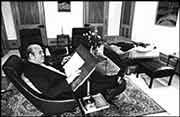History
In the 1950s, Silvio Fanti tried to remedy certain shortcomings of the classic analytic framework. He progressively developed a new working rhythm to help the analysand to relax and to encourage their associative verbalisation by lengthening the duration of the sessions, which he set at three hours a day. He soon saw that this innovation facilitated resolution of the neurotic conflict.
This was the origin of the long sessions, which are the cornerstone of this method.

Doing a psychoanalysis means exploring our unconscious, which decides our lives. But the unconscious, belonging to another level of reality, evades all attempts at cognitive understanding. To remedy this difficulty, Freud experimented with the method of free associations: on the couch, the analysand lets themself go and describes whatever comes to mind and what they feel, without worrying about the logic of what they are expressing. In this way, the analysable manifestations of the unconscious gradually reveal themselves.
To optimise this Freudian method of free associations, Fanti introduced a new rhythm for sessions.
The notion of long session involves two complementary and indissociable parameters: duration and frequency.
- The sessions of three hours prove to be physiological: the analysand has time to relax and associatively recount their life and dreams in the smallest detail, letting emotions emerge. The subjects or themes evoked gradually find correspondences and equivalents which interconnect them. These points of interconnection are precious indicators of unconscious nuclei.
This schema of the passage of the unconscious to consciousness requires two to three hours every day.
- The working through made in the course of a session is taken up again and developed in the next day’s session or the one after that, and so on. In addition, certain current elements (family, social and professional contacts, emails and telephone calls) and, above all, dreams can integrate themselves day by day into the associative material of the analysand. The almost daily frequency of the sessions thus ensures a widening and continuity of the passage to consciousness of the unconscious.
Work which can be done in tranches
A psychoanalysis in long sessions is done continually or in tranches of several weeks, with intervals of some months for pauses of sedimentation.
A tranche of long sessions can be decisive in resolving a current problem, placing it in its vital context and providing a new breathing space. For example, loss of employment, illness, separation, bereavement, mid-life crisis, and the beginning of presenescence.
